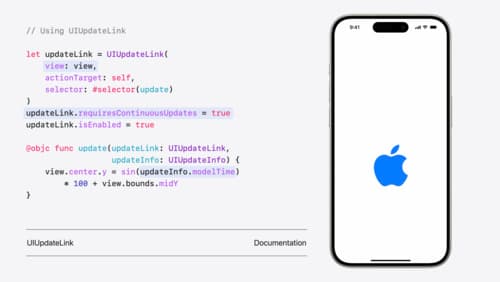swiftui vs uikit
Asked on 2024-07-31
2 searches
SwiftUI and UIKit are both powerful frameworks for building user interfaces on Apple platforms, but they have different design philosophies and use cases.
SwiftUI
- Declarative Syntax: SwiftUI uses a declarative syntax, meaning you describe what the UI should look like and the framework takes care of the rest. This can lead to more readable and maintainable code.
- Cross-Platform: SwiftUI is designed to work across all Apple platforms, including iOS, macOS, watchOS, tvOS, and visionOS. This allows for more code sharing between different platform versions of an app.
- Interoperability: SwiftUI can interoperate with UIKit and AppKit. You can embed UIKit views in SwiftUI and vice versa using
UIViewRepresentableandUIHostingControllerrespectively. This makes it easier to incrementally adopt SwiftUI in existing projects. - Advanced Features: SwiftUI includes advanced features like custom animations, gesture recognizers, and modifiers to fine-tune the look and feel of your app. It also supports new capabilities like custom containers, mesh gradients, and scrolling customizations (Platforms State of the Union).
UIKit
- Imperative Syntax: UIKit uses an imperative approach, where you explicitly define the steps to create and update the UI. This can offer more control but may result in more complex code.
- Mature and Feature-Rich: UIKit has been around for a long time and is very mature. It offers a wide range of built-in components and is highly customizable.
- Interoperability: UIKit can also interoperate with SwiftUI. You can use SwiftUI animations and gesture recognizers within UIKit views, making it easier to build fluid, gesture-driven animations (What’s new in UIKit).
- Specific Use Cases: UIKit is often used for more complex, performance-critical applications where fine-grained control over the UI is necessary.
Summary
- SwiftUI is ideal for new projects or when you want to share code across multiple Apple platforms. It offers a modern, declarative approach to UI development.
- UIKit is better suited for existing projects or when you need the mature, feature-rich capabilities it offers. It provides more control and is highly customizable.
For more detailed information, you can refer to the sessions:

SwiftUI essentials
Join us on a tour of SwiftUI, Apple’s declarative user interface framework. Learn essential concepts for building apps in SwiftUI, like views, state variables, and layout. Discover the breadth of APIs for building fully featured experiences and crafting unique custom components. Whether you’re brand new to SwiftUI or an experienced developer, you’ll learn how to take advantage of what SwiftUI has to offer when building great apps.

What’s new in UIKit
Explore everything new in UIKit, including tab and document launch experiences, transitions, and text and input changes. We’ll also discuss better-than-ever interoperability between UIKit and SwiftUI animations and gestures, as well as general improvements throughout UIKit.

Platforms State of the Union
Discover the newest advancements on Apple platforms.
